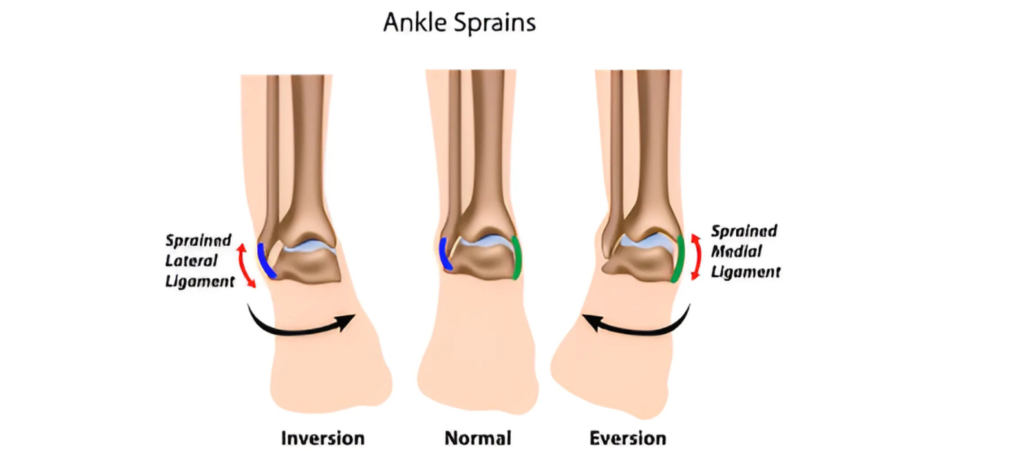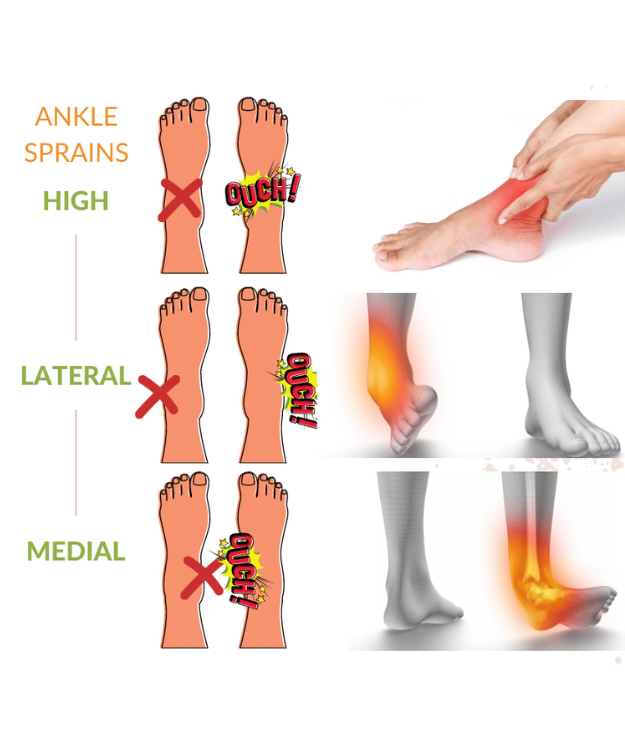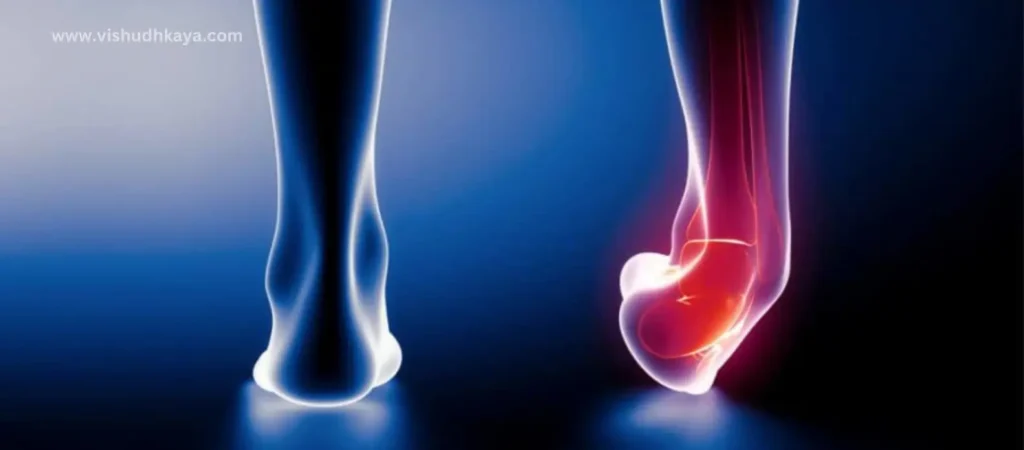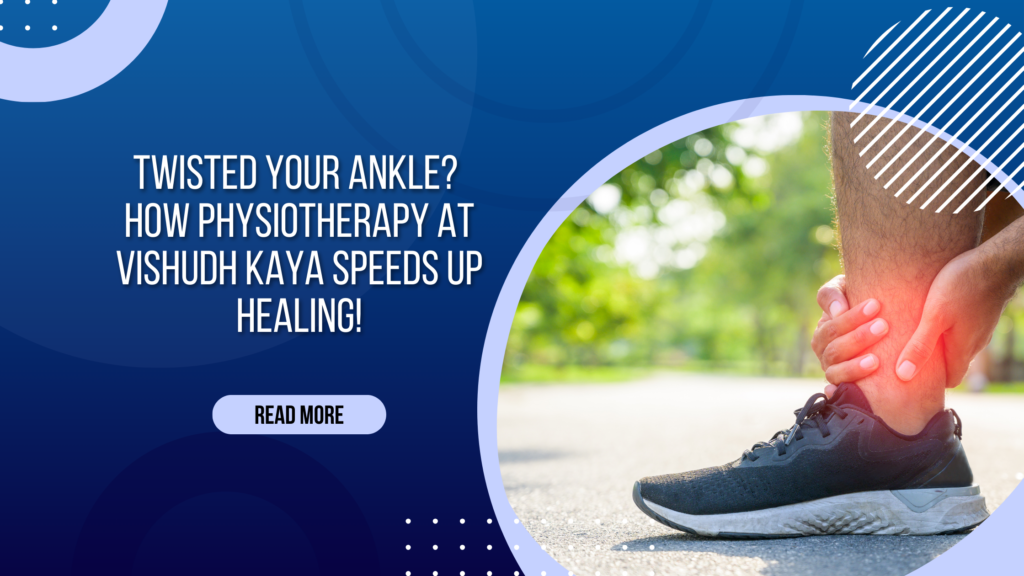Imagine you’re rushing down the stairs, arms full of groceries, when your foot suddenly lands awkwardly on the edge of a step. A sharp pain shoots through your ankle, forcing you to grab onto the railing for support. Twisting an ankle can happen in the blink of an eye, whether during a hectic day or a moment of distraction.
An ankle sprain may seem minor, but it can severely limit mobility and disrupt your daily routine. The swelling, pain, and reduced movement make even the simplest tasks feel like a challenge, and without the right care, recovery can take longer than expected. An ankle sprain occurs when the ligaments supporting the ankle joint are stretched or torn due to a sudden twist, roll, or impact. The most commonly affected are the lateral ligaments on the outer side of the ankle, including the anterior talofibular ligament (ATFL), which is most frequently damaged, the calcaneofibular ligament (CFL) in moderate to severe cases, and the posterior talofibular ligament (PTFL) in severe injuries. On the inner side, the strong deltoid ligament may be injured during eversion sprains (when the ankle rolls inward). In some cases, syndesmotic ligaments, which connect the tibia and fibula above the ankle, are damaged during twisting motions, leading to high ankle sprains. While sprains primarily affect ligaments, nearby muscles, and tendons, such as the peroneal muscles on the outer side of the ankle, may also be strained as they work to stabilize the joint.
In this blog, we’ll unpack everything you need to know about ankle sprains—from their common causes to recognizing symptoms and finding the best Ankle sprain treatment. We’ll also introduce you to how Vishudh Kaya Pain Relief and Multispeciality Clinic combines cutting-edge chiropractic, osteopathy, and physiotherapy techniques to help you heal quickly and effectively.
Let’s get started on the path to recovery!
1. What Happens When You Twist Your Ankle?
An ankle sprain occurs when the ligaments in the ankle are stretched or torn, typically due to an unexpected twist or forceful movement. These ligaments are responsible for stabilizing the ankle, and any injury to them can lead to pain, swelling, and difficulty moving the joint.
❖ How Do Ankle Sprains Happen?
Ankle sprains are often caused by the ankle being forced out of its normal position. Common causes include:
● Sudden movements: Twisting or rolling the ankle quickly, often during physical activity.
● Poor footwear: Wearing shoes that don’t offer enough support or cushioning.
● Sports-related activities: Rapid movements, jumps, or awkward landings during sports.
● Uneven surfaces: Walking or running on uneven ground that causes the ankle to twist unexpectedly.
Not Sure If You’ve Sprained Your Ankle?
If you think you’ve injured your ankle, it’s essential to get it checked right away. Vishudh Kaya’s specialists are here to evaluate Ankle injury rehabilitation and Faster healing for sprained ankles, Contact us today!
2. Common Symptoms of an Ankle Sprain

❖ Is It Just a Sprain or Something More? Here Are the Key Symptoms of Ankle Sprains
An ankle sprain can present itself with varying degrees of discomfort. Common symptoms include:
● Swelling: Swelling is typically the first sign of an ankle sprain, as the body sends fluid to the injured area to protect it. The swelling may develop quickly and can range from mild puffiness to more significant swelling, making the ankle look visibly larger.
● Bruising: After an ankle sprain, bruising or discolouration often appears due to ruptured blood vessels. The skin may turn shades of purple, blue, or yellow as the blood leaks into the surrounding tissue. Bruising may continue to spread in the days following the injury, gradually fading as healing progresses.
● Pain: Pain is a hallmark symptom, with its intensity varying according to the severity of the sprain. For a mild sprain, pain is generally mild and may only be felt when moving or pressing on the ankle. A moderate sprain causes more persistent pain, especially when walking or putting weight on the foot. Severe sprains can lead to sharp, constant pain, even while resting, with the ankle feeling weak or unstable.
● Difficulty walking: Difficulty walking is common with an ankle sprain. Mild sprains may still allow you to walk, though with some discomfort. In more severe sprains, walking can be extremely painful, or it may be impossible, as the ankle may not be able to support your weight due to pain or instability.
The severity of these symptoms can vary, so it’s important to assess your injury promptly and seek treatment to prevent further complications.
❖ Understanding the Different Degrees of Ankle Sprains
Ankle sprains are classified into three degrees based on the severity of the ligament damage, each with distinct symptoms and impact on function:
1) Mild sprain: The ligament is stretched but not torn. This results in minimal pain and slight swelling, with some discomfort during movement. You may still be able to walk with little difficulty, and normal activities can generally continue with some caution.
2) Moderate sprain: The ligament suffers partial tears, leading to more noticeable pain, swelling, and difficulty moving the ankle. You may experience a reduced range of motion and have trouble walking or putting weight on the foot without discomfort. More rest and care are required for recovery.
3) Severe sprain: In a severe sprain, the ligament is completely torn or ruptured. This causes intense pain, significant swelling, bruising, and an unstable ankle. Movement becomes very painful or impossible, and walking or bearing weight on the affected foot is usually not feasible without medical intervention.
The degree of the sprain affects treatment and recovery time, so identifying the severity is crucial to proper care.
Experiencing These Symptoms?
If you’re experiencing any of these symptoms, don’t wait for the injury to worsen. Vishudh Kaya offers effective treatments to help reduce swelling and promote healing. Contact us now to get the care you need!
3. Types of Ankle Sprains: Mild, Moderate, and Severe

❖ How Do You Know the Severity of Your Ankle Sprain? Here’s What You Should Look For.
Ankle sprains are categorized into three degrees, depending on how much damage has occurred to the ligaments:
● Mild Sprain: The ligament is stretched, causing only mild pain and swelling. Recovery is typically fast, with most people healing within a few days with minimal treatment.
● Moderate Sprain: This involves partial tearing of the ligament, leading to more significant pain, swelling, and difficulty moving the ankle. Recovery may take a few weeks, with additional care such as bracing or physical therapy.
● Severe Sprain: The ligament is completely torn, resulting in intense pain, severe swelling, and instability. Healing can take weeks to months and may require more intensive treatment, including surgery or long-term rehabilitation.
The severity of your sprain directly influences the treatment approach and the time needed for full recovery.
Wondering how severe your sprain is? Vishudh Kaya can provide an accurate diagnosis and help you find the right treatment for your ankle sprain.
4. Common Causes of Ankle Sprains

❖ Why Did You Sprain Your Ankle? Here Are the Top Causes You Need to Know.
A sprain happens when your ankle moves beyond its normal range of motion, resulting in the stretching, partial tearing, or complete rupture of one or more of the ligaments in the ankle.
Common Causes of Ankle Sprains:
● Sudden Twists, Turns, or Impacts: Quick directional changes or impacts during sports or physical activities can cause the ankle to twist, resulting in a sprain.
● Improper Footwear: Wearing shoes that don’t provide adequate support can increase the risk of rolling or twisting the ankle.
● Uneven Surfaces: Walking or exercising on uneven terrain can lead to ankle instability and sprains.
● Falls or Tripping: Losing balance or falling can force the ankle into an unnatural position, leading to a sprain.
● Landing Awkwardly: Jumping or pivoting incorrectly can cause a sprain when landing with improper foot alignment.
● Sports Injuries: In activities like basketball, football, or soccer, an opponent stepping on or landing on your foot can also cause an ankle sprain.
These incidents place significant stress on the ligaments, often leading to an ankle sprain.
Have you sprained your ankle before? Vishudh Kaya’s rehabilitation programs can help prevent future sprains and restore full mobility.
5. Risk Factors for Ankle Sprains
❖ Are You at Greater Risk of Spraining Your Ankle? Find Out What Makes You More Vulnerable.
Certain factors can increase the likelihood of spraining your ankle:
✔ Weak Ankle Muscles: Insufficient muscle strength around the ankle can lead to instability, making it more prone to injury.
✔ Previous Injuries: If you’ve had an ankle sprain before, the ligaments may be weaker, raising the chances of re-injury.
✔ High-Risk Sports: Activities that involve quick movements, jumps, or sudden direction changes, such as basketball, soccer, and running, can put extra strain on the ankle.
✔ Age: Younger individuals may experience more sprains from high activity levels, while older individuals might face decreased flexibility or weakened ligaments, making them more vulnerable.
✔ Improper Footwear: Wearing shoes that don’t provide adequate support, such as high heels or worn-out sneakers, increases the risk of an ankle sprain.
✔ Uneven Surfaces: Walking or exercising on uneven terrain can cause the foot to roll, leading to a sprain.
✔ Skipping warm-up & stretching: Failing to properly warm up or stretch before physical activity can leave the ankle more susceptible to injury.
Recognizing these risk factors can help you take precautions like strengthening your ankle muscles, wearing proper footwear, and warming up before physical activities to lower your risk.
Vishudh Kaya can help you strengthen your ankles with Physiotherapy for ankle sprain and reduce the risk of future sprains with targeted exercises and treatments.
6. How is an Ankle Sprain Diagnosed?
❖ Is It Just a Sprain, or Could It Be Something More? Here’s How We Diagnose Your Injury.
Understanding the exact nature of an ankle injury is crucial for effective treatment. Here’s what the diagnostic process involves:
● Physical Examination: A comprehensive check of your ankle to assess swelling, bruising, pain points, and mobility.
● Imaging Studies: X-rays may be performed to exclude fractures, and an MRI can provide detailed insights into ligament or soft tissue damage, if necessary.
Accurate diagnosis is the foundation of creating a personalized treatment plan to ensure proper healing and recovery.
Unsure how severe your ankle injury is? Let Vishudh Kaya’s specialists assess your condition and guide you toward the best Ankle sprain treatment.
7. Treatment Options for Ankle Sprains

❖ To effectively treat an ankle sprain, a range of methods can help reduce pain, promote healing, and prevent further damage. Here’s an outline of key treatment options:
Traditional R.I.C.E. Method:
o Rest: Allow the injured ankle to rest and avoid putting weight on it to prevent aggravating the injury.
o Ice: Use ice packs on the ankle to reduce swelling and numb the area, providing pain relief.
o Compression: Applying an elastic bandage helps to control swelling and provide support.
o Elevation: Raise the ankle above heart level to help minimize swelling.
✔ Physical Therapy:
After the initial healing phase, physical therapy is essential to restore strength, flexibility, and stability to the ankle. Targeted exercises help improve the range of motion and reduce the risk of re-injury.
✔ Advanced Therapies:
For more serious sprains, advanced treatments like manual therapy (joint manipulation and soft tissue work) can help restore function and relieve pain. Electrotherapy may also be used to accelerate healing and reduce discomfort.
Vishudh Kaya’s holistic treatments can help reduce pain, accelerate healing, and restore full ankle function. Contact us today for a personalized treatment plan.
8. How Vishudh Kaya Can Help with Faster healing for sprained ankle
❖ Ankle Sprain Recovery the Vishudh Kaya Way: A Comprehensive and Personalized Approach
At Vishudh Kaya, we offer a holistic and personalized recovery plan for your ankle sprain, integrating a range of treatments to ensure effective healing:
❖ Physiotherapy: Targeted exercises and manual techniques to reduce swelling, restore mobility, and strengthen the ankle.
❖ Osteopathy: Hands-on methods to improve joint movement, enhance circulation, and support faster healing.
❖ Chiropractic Care: Focuses on correcting misalignments to improve ankle stability and optimize healing
❖ Ayurveda: Natural therapies like herbal remedies and oil massages to reduce inflammation and aid in the body’s healing process.
❖ Homeopathy: Uses natural remedies tailored to your specific symptoms to reduce pain, promote healing, and restore balance.
● Personalized Care: With a customized treatment approach, Vishudh Kaya ensures faster recovery, improved flexibility, and a reduced risk of re-injury.
If you’re dealing with an ankle sprain, Vishudh Kaya’s holistic approach can speed up your recovery and get you back on your feet faster. Book your consultation today!
9. Preventing Future Ankle Sprains
❖ How to Protect Your Ankles from Future Injuries: Simple Prevention Tips Taking steps to strengthen and stabilize your ankles can significantly lower the risk of injury. Here’s how:
❖ Strengthen Ankle Muscles: Engage in exercises like resistance band stretches and calf raises to improve ankle stability.
❖ Focus on Balance: Incorporate balance drills such as standing on one leg or practising with a wobble board to enhance coordination.
❖ Wear the Right Footwear: Select shoes with adequate support and cushioning tailored to your activities.
❖ Stretch and Warm Up: Before any physical activity, ensure you warm up and stretch to prepare your muscles and joints.
By following these preventive measures, you can keep your ankles strong and less prone to injury.
Don’t let ankle sprains slow you down again. Vishudh Kaya can help you build ankle strength and prevent future injuries through targeted training and rehabilitation.
10. When Should You Seek Medical Help for an Ankle Sprain?
Not Sure When to See a Doctor? Here’s When You Should Seek Help for Your Ankle Sprain.
❖ Intense Pain: If the pain is severe and doesn’t ease with rest, ice, or over-the-counter pain relief, it could be a sign of a more serious injury.
❖ Inability to Bear Weight: If you can’t walk or stand on the injured ankle, it may indicate significant damage to the ligaments or even a fracture.
❖ Excessive Swelling: If swelling is severe and doesn’t improve, medical evaluation is needed to rule out serious complications.
Early diagnosis and treatment are key to avoiding long-term issues such as instability or chronic pain.
If your ankle sprain isn’t improving or is affecting your daily life, don’t wait. Vishudh Kaya’s expert team is here to help you heal.
Conclusion – Effective diagnosis and treatment of an ankle sprain are crucial for preventing ongoing issues like chronic pain or instability. Early treatment can help control swelling, restore movement, and strengthen the ankle, ensuring a quicker recovery.
If you’re dealing with an ankle sprain, don’t wait for it to get worse. Professional care is essential for proper healing. At Vishudh Kaya, our team offers tailored treatment options to help you recover fully and return to your normal activities confidently.
Ankle sprains don’t have to sideline you for long. Visit Vishudh Kaya for effective treatments that promote healing and prevent future injuries. Get back to your active life today!
“Struggling with an ankle sprain? Let Vishudh Kaya Pain Relief and Multispeciality Clinic guide your recovery with expert physiotherapy. Take the first step toward pain-free movement—schedule your consultation today and start healing!”
📞 Call us at: +91-76781 35151
📍 Visit us at: #8566, Sector 125, Sunny Enclave, Kharar, Mohali, Punjab 140301
🌐 Book online at: https://vishudhkaya.com
Don’t wait—empower yourself with Vishudh Kaya Pain Relief and Multispeciality Clinic!


